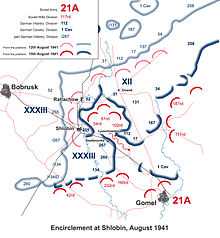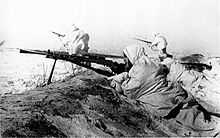112th Infantry Division (Wehrmacht)
| German 112th Infantry Division 112. Infanterie-Division | |
|---|---|
|
Divisional insignia of the 112th Infantry Division | |
| Active | 1940–43 |
| Country |
|
| Branch |
|
| Size | Division |
| Engagements | |
The 112th Infantry Division (German: 112. Infanteriedivision) was a German Army infantry division active in World War II.

History
The division was formed in December 1940 from elements of 34th Infantry division and 33rd infantry division, as part of the 12th wave of German mobilization.[1]
The 112th Infantry Division remained in OKH reserve during the opening phase of operation Barbarossa, and was committed to the southern wing in the second half of July during the battle of Smolensk.[2] Here elements of the Soviet 21st Army had pushed back forward German elements and advanced up to 80 kilometers in to the German rear.[3]
In the beginning of August the 112th division is manning defensive positions on the Army group southern flank, as part of 2nd Armies XII Corps. As Gurderians 2nd Panzer groups starts its wheel from Smolensk to the south on 8 August, 2nd Army, on its right flank, is slow to join in because of poor weather, ammunition shortages, and the hesitancy of General Weichs, its Army commander.[4]
On 12 August the 2nd Army finally launches its attack south-east of Bobrusk, cracks the defenses the Soviet 21st Army, and in three days fighting encircles the bulk of the soviet 63rd Riffle corps in a pocket at Shlobin.
Lacking in mobile units, the 112th division, still part of XII Army Corps, forms the eastern pincer of the attack breaking through successive defensive lines and eventually linking up with 267th Infantry division coming from the other way, near the village of Ljuschowskaja and the Saltanovka railway station, on the Shlobin - Gomel railine. Stretching a thin barrier across the Soviet Corps escape rout, the 112th Division spends the next 3 days fending off repeated, and increasingly desperate escape attempts. By 20 August General Feldt’s 1st Cavalry Division had captured Gormel, and 2nd army tallied its acomplisments, totalling 78,000 prisoners, 700 guns, and 144 tanks, many of these from the Shobin pocket.

By the tail end of October the encirclement battles around Briansk were over, the 112th crossed the Oka river south of Belev, inching its way forward slowly through the mud, but the advance was breaking down due to deteriorating road conditions and supply difficulties. The long eastern flank of 2 panzer group was a problem, and Generaloberst Guderian shifted the 112th division as part of the LIII corps to his right to shore up the protection there [5]
The division, redeploying to the region south of Tula, met forces from the Soviet 13th Army near Teploye, who were attempting to drive on Tula from the east and disrupt the German amoured thrust towards Moscow. The Soviets using the superior mobility of their cavalry units, delayed the LIII corps mission so much so, that Guderian had to reinforce it with tanks, artillery and flak, a move which slowed the whole advance of the Panzer Grupe. With the aid of the reinforcements, the 112th infantry division drove the 13th Army forces off to the east and advanced towards Stainogorsk. Here it was attacked by newly arrived Siberian infantry, supported by tanks, suffered a severe reverse, and showed 'signs of panic'. [6] Unprepared ofr the winter conditions, each infantry regiment had already lost 500 men to frostbite, and in the server cold machine guns failed to fire. The division was now very weak and unable to advance further.[6] On 2 November 1942 the division was disbanded. The remaining infantry were amalgamated and formed into the 112 divisional group (a regimental equivalent) and along with support elements from the division were used to build Corps Detachment B.[1]
Organization
1941
- 110 Infantry Regiment
- 256 Infantry Regiment
- 258 Infantry Regiment
- 86 Artillery Regiment
- 112 Anti-tank battalion
- 120 Reconnaissance battalion
- 112 Engineer battalion
- 112 Signals battalion
- 112 Division services
Commanders
- General der Infanterie Friedrich Mieth (10 December 1940 – 10 November 1942)
- Generalmajor Albert Newiger (10 November 1942 – 20 Juni 1943)
- General der Artillerie Rolf Wuthmann (20 Juni – 3 September 1943)
- Generalleutnant Theobald Lieb (3 September 1943 – unknown)
References
- ↑ 1.0 1.1 George F. Nafziger, German Order of Battle: Infantry in World War II, p 152-153
- ↑ David M. Glantz, The Initial Period of War on the Eastern Front, 22 June - August 1941, see maps pages 222, 224, 225, 379, 426, 430
- ↑ David M. Glantz, Barbarossa Derailed: The Battles for Smolensk, July–August 1941 Volume 1
- ↑ Glantz, David M. (2010-11-02). Barbarossa Derailed: The Battle for Smolensk 10 July-10 September 1941, Volume 1: The German Advance, The Encirclement Battle, and the First and Second Soviet Counteroffensives, 10 July-24 August 1941 (Kindle Location 8496).
- ↑ W.V. Madeja, Russo-German War, Autumn 1941, p35-39
- ↑ 6.0 6.1 General Heinz Guderian, Panzer leader, p248
| ||||||||||||||||||||||||


.svg.png)